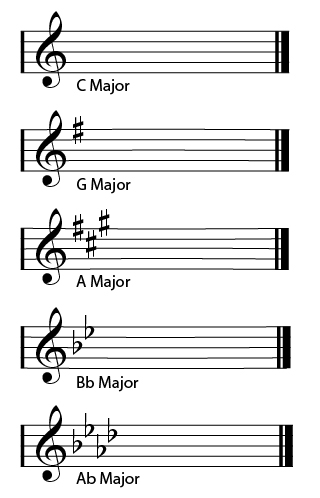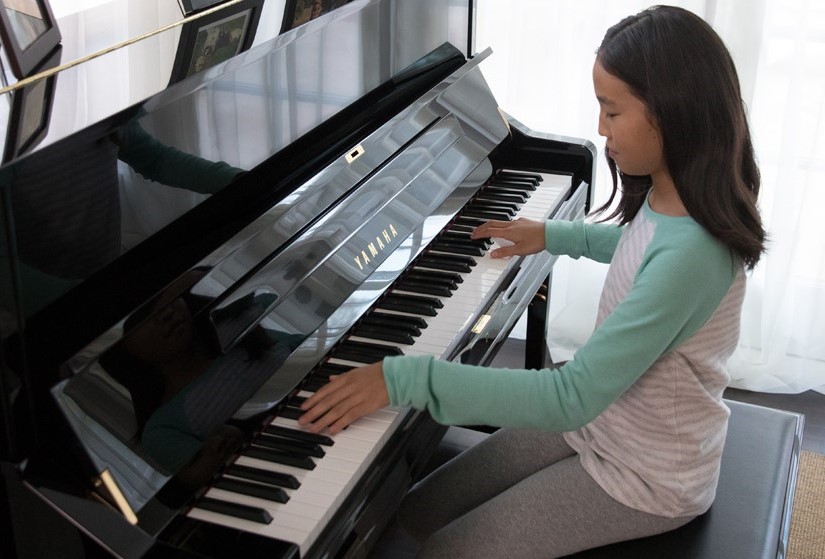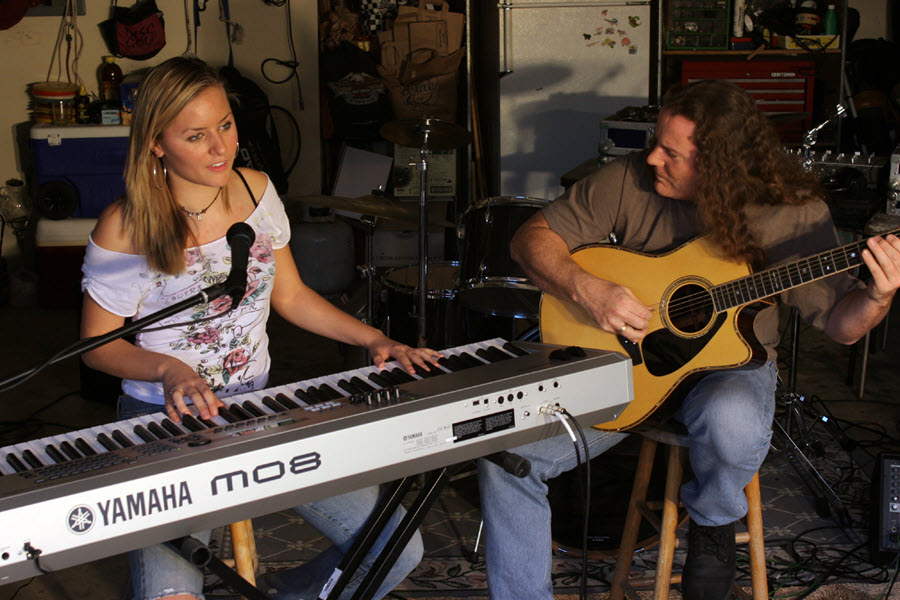Tagged Under:
Navigating a Score
Learn to follow the road map of a written piece of music.
There’s more to reading a score than just learning the notes, the rhythms and the chords. In this article, we’ll tell you what’s involved, with tips for navigating the various symbols and markers you’re likely to encounter.
Key Signature and Time Signature
There are two vital pieces of information that you’ll find at the beginning of every written piece of music, and they establish important rules for what will follow.
The first is called the key signature, and it consists of a group of sharps or flats, placed right after the musical clef. (As a keyboard player, you’ll usually be following the treble clef only, but in some sheet music — for example, in all classical music scores — there will be a treble clef for the right hand and a bass clef for the left).
The second is called the time signature, and it follows the key signature on the staff. Here is the beginning of a piece for piano, with these elements labeled for you:

Let’s look at these in greater detail.
Key Signature
Most music tends to be based on a certain scale (or key center), and that means it will be made up of combinations of white and black keys. The key signature at the beginning of printed music tells you which black-key notes (i.e., sharps and flats) will be used often throughout the piece. (This saves the printed music from having to show a lot of sharp or flat signs in every measure.) So when you first look at a new piece of music, you need to — pardon the pun — take note of this.
Here are some common key signatures:

Time Signature
The time signature describes the general rhythm and feel of a piece of music by telling us how to count the bars and what the basic unit of counting is. The top number indicates how many beats are in each measure, and the bottom number indicates the rhythmic unit that gets each beat.
Here are some common time signatures:

Signs and Symbols
The most common navigational symbol is a pair of brackets with a pair of dots inside them. Together, these are called a repeat sign. The first bracket is the Start Repeat, and the second one is the End Repeat:

These tell you to play the bracketed section twice (unless otherwise marked). So for the example above, you would play bars 1-2-3-4-1-2-3-4 and then move on to the rest of the score.
Bear in mind that repeat signs don’t always have to occur at the beginning of a line of music. For example, you might see this:

Here, you would play bars 1-2-3-4-3-4 and then continue on.
When you need to repeat a bracketed section more than twice, the score will have an instruction telling you how many times to repeat, like this:

This would be played as 1-2-3-4-3-4-3-4 and then onward.
Another common occurrence is when a section is meant to repeat, but with some small differences in the end of each phrase. Those situations utilize what are called numbered endings, i.e., 1st ending, 2nd ending and so forth. For instance:

Here, you would play up to the first ending’s End Repeat sign and then go back to the Start Repeat sign. At that point, you’d play through, but this time go to the second ending and onward, so for this example, it would be played as 1-2-3-4-1-2-3-5-6-7-8 and onward.
There are some other signs that tell you where to go back to after encountering an End Repeat sign. For example, the symbol D.C. (Da Capo) at the end of a section is an instruction to go back to the very top of the score. So when you see it, you don’t need to look for a Start Repeat sign; you just jump back to the beginning.

The “roadmap” for this piece of music would be 1-2-3-4-5-6-7-8-5-6-7-9-10-11-12-13-14-15-16-1-2-3-4-5-6-7-8-5-6-7-9-10-11-12-13-14-15-16 and onward. Whew!
You don’t always have to go back to the top, or to a Start Repeat sign, either. The D.S. (Dal Segno) sign is used to indicate a specific bar to go back to. It looks like this:

Here it is in use:

Here, you would play through both endings as usual, and then continue to the bar that has the D.S. instruction in it. From there, you’d jump back to wherever the D.S. sign is and then continue playing onward. The roadmap for this example would be: 1-2-3-4-1-2-3-5-6-7-8-9-10-11-12-7-8-9-10-11-12 and so on.
There are also ways to indicate how far to play after going back to the D.S. sign. A common one used in classical music is D.S. al Fine, which means, “go back to the D.S. sign and play until you come to a bar that is marked Fine.” Note that this doesn’t have to be at the end of the piece. If it comes earlier, you don’t do anything special when you first pass through that bar — just keep going. You only observe the Fine after having gone back using a D.C. al Fine or D.S. al Fine sign.
Here’s an example of how it works:

This would be played 1-2-3-4-1-2-3-5-6-7-8-9-10-11-12-13-14-15-16-7-8-9-10-11-12-13 and done.
A common method of navigational instruction after using a D.C. or D.S. sign is to use what is called a Coda sign.

This is an instruction to jump to a new section of music that is usually (but not always) an extended section leading up until the end of the piece. If you encounter a D.S. al Coda sign at the end of a bar, you need to jump back to the D.S. sign and play until you encounter a bar that contains a Coda sign, or the words To Coda/Al Coda. Then you jump to whatever later bar has the Coda sign at the beginning of the measure. Here’s an example:

The roadmap here would be 1-2-3-4-1-2-3-5-6-7-8-9-10-11-12-7-8-9-10-13-14-15-16.
Repeat signs and symbols serve a very useful purpose; without them, most pieces of sheet music would be quite long … and it’s difficult to keep turning pages while you are playing!
Look for Changes
Checking a piece of music ahead of time for key signatures, time signatures and repeat signs allows you to pre-plan your journey before you attempt to actually play the music. However, they don’t always remain the same from start to finish, so you should always look through the score carefully to see if any of them change during the course of the piece. If such a change occurs within a staff, it will be notated at the start of the first bar of the change; if it’s going to happen on the next line or stave, there will usually be a cautionary indication to warn you that it is about to happen.
As an example, here’s a piece of music that goes through a lot of time changes:

The time change to 2/4 in bar 7 comes in the middle of the line, so it’s indicated immediately, but for the change to 6/8 that occurs in bar 13, there is a cautionary indication at the end of bar 12 to help warn you ahead of time — same thing for the return to 4/4 that happens in bar 21.
Changes in key signatures are usually referred to as a modulation, and the same cautionary indications are used if they occur on the next line or stave. For example:

This piece starts in the key of C (no sharps or flats) and then modulates to the key of A (three sharps) at bar 7. The next key change, to the key of B-flat (two flats) occurs at bar 13, but since it is at the start of a stave, a cautionary warning appears at the end of bar 12. Bar 16 returns to the key of C, and to indicate no sharps or flats, natural signs are used to say, “stop using the B-flat and E-flat you were using previously.”
Many professional musicians circle (or use a highlighter to annotate) these important instructions to draw attention to them before ever playing through the piece. You’d never take a trip without knowing where you’re going. The same is true for playing sheet music and written scores. Be prepared!
Check out our other Well-Rounded Keyboardist postings.
Click here for more information about Yamaha keyboard instruments.














